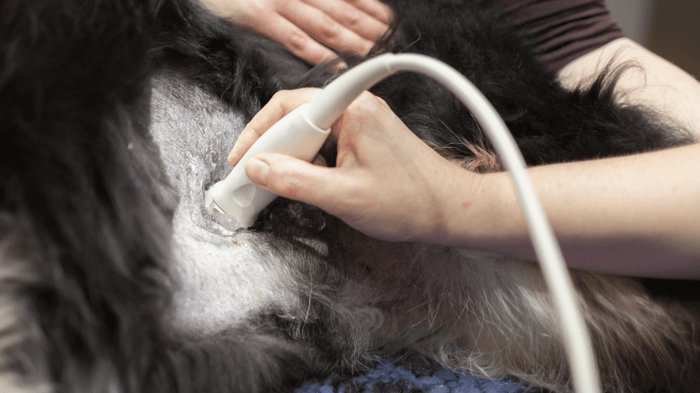Knowing how to tell if a dog is pregnant can be a bit tricky, especially if you’re not familiar with the signs to look for. However, several indicators can help you determine if your canine companion is expecting.
Knowing what to look for can help you prepare for the arrival of new puppies and ensure your dog receives the proper care. You’ll also do everything to make the future puppy mama as comfortable as possible, such as taking their cozy beds where they choose to nest.
If you suspect that your dog may be pregnant, schedule an appointment with your veterinarian. Using expert sources like Eleanor Winter’s So Your Bitch is Pregnant, let’s get right into canine pregnancy.
So, How To Tell If A Dog Is Pregnant?
A swollen belly is one of the most obvious signs that a dog is pregnant. Another sign to look for is changes in behavior. Pregnant dogs may become more affectionate or protective and may also experience changes in appetite or energy levels. Other signs include bigger nipples, possible morning sickness, weight gain, nipple color changes, and nesting behavior.
Maybe you ran a bit late spaying your dog and are worried your pup is pregnant with some neighborhood dog. You may even have rescued a lady pup that is a bit on the chonky side, and you are curious if they’re pregnant. No matter the case, knowing canine pregnancy signs will answer your questions.
Young dogs tend not to show their pregnancy until quite late in their pregnancy. In many cases, you may not see many signs until the last two weeks, when she may suddenly seem to balloon.
It’s important to note that some dogs may exhibit signs of pregnancy even if they’re not pregnant, a false pregnancy. Our article on how many litters dogs can have emphasizes either spaying your dog or letting them have litters back to back to prevent phantom pregnancies.
@romeo.ava94Replying to @bdottadott I tried to keep tabs off her growth 🥰 #fypシ #foryou #dogfamily #pitbullmix #pitbullsoftiktok #pregnant #puppieslover #newpuppiescoming
♬ Don’t Let Me Down – The Chainsmokers
Overall, determining if a dog is pregnant requires careful observation and, in some cases, a visit to the veterinarian. By paying attention to physical and behavioral changes, you can get a better idea of whether or not your dog is expecting.
Physical Changes in a Pregnant Dog
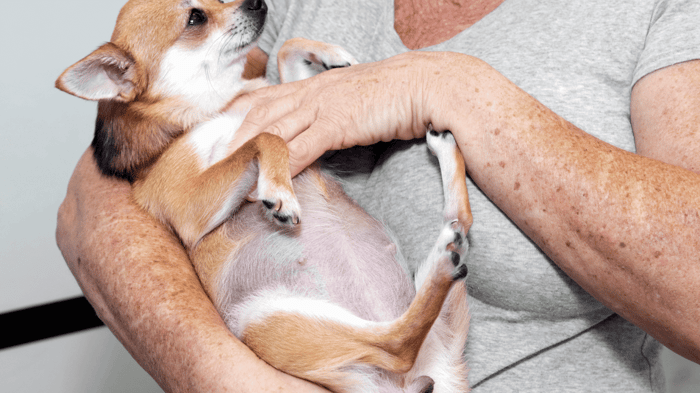
When a dog becomes pregnant, there are several physical changes that occur. The dog owner can observe these changes and head to the vet for confirmation. This section will discuss the most common physical changes in a pregnant dog.
Increased Appetite
An increased appetite is one of the first signs of pregnancy in a dog. Pregnant dogs require more nutrients to support the growth and development of their puppies. As a result, they will eat more food than usual. Research shows pregnant dogs eat about 1 to 1.5 times more than their normal intake.
Enlarged Abdomen
As the pregnancy progresses, the dog’s abdomen will enlarge as the puppies grow. This can be observed by measuring the dog’s waistline or by feeling the abdomen. A bigger abdomen is the most obvious dog pregnancy sign.
Weight Gain
The dog’s weight will also increase as the pregnancy progresses. It is essential to monitor the dog’s weight gain and ensure it is within a healthy range.
Changes in Nipple Size and Color
Another physical change in pregnant dogs is a change in nipple size and color. The nipples will become larger and darker in color as the pregnancy progresses. This is due to the increased blood flow to the mammary glands in preparation for nursing the puppies.
Possible vomiting
Morning sickness is yet another common sign that puppies are on the way. If your dam (mother dog) was fine and suddenly started throwing up, she may be pregnant. Be keen on dogs that throw up too much for an extended period because that may mean something is wrong, and they need a visit to the vet.
Week-By-Week Dog Pregnancy Signs
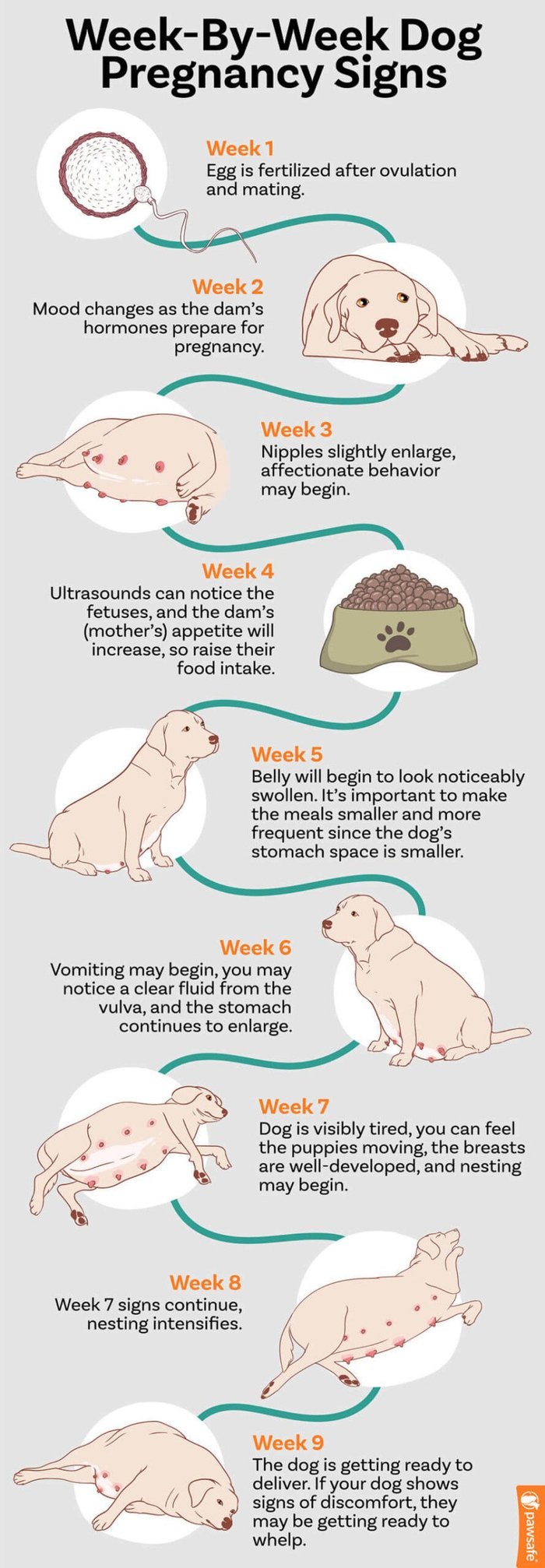
Dogs are pregnant for about nine weeks with these signs:
Week 2 (days 8 to 14) – You may observe mood changes as the dam’s hormones prepare for pregnancy. However, there are often not many signs at this stage.
Week 3 (days 15 to 21) – Nipples slightly enlarge, affectionate behavior may begin.
Week 4( days 22 to 28) – Ultrasounds can notice the fetuses, and the dam’s (mother’s) appetite will increase, so raise their food intake.
Week 5 (days 29 to 35) – Your dog’s belly will begin to look noticeably swollen. It’s important to make the meals smaller and more frequent since the dog’s stomach space is smaller.
Week 6 (days 36 to 42) – Vomiting may begin, you may notice a clear fluid from the vulva, and the stomach continues to enlarge.
Week 7 (days 43 to 49) – The dog is visibly tired, you can feel the puppies moving, the breasts are well-developed, and nesting may begin.
Week 8 (days 50 to 56) – Week 7 signs continue, nesting intensifies.
Week 9 (days 56 to 63) – The dog is getting ready to deliver. If your dog shows signs of discomfort, they may be getting ready to whelp.
Behavioral Changes in a Pregnant Dog
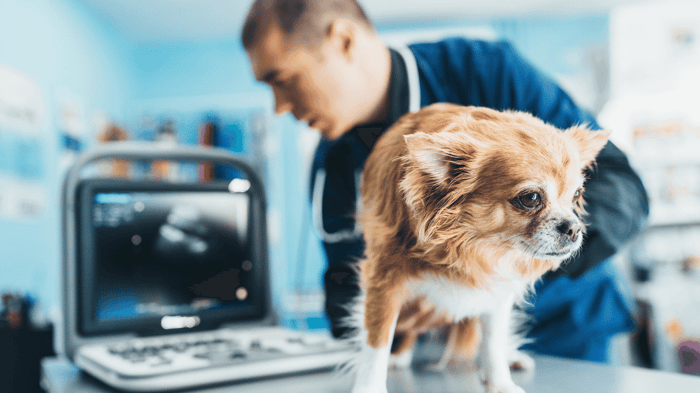
When a dog is pregnant, her body undergoes many changes that can alter her behavior. These changes are caused by hormonal fluctuations and can manifest in various ways. Here are two common behavioral changes that can indicate that a dog is pregnant:
Increased Affection (Sometimes Decreased)
Increased affection is one of the most noticeable changes in a pregnant dog’s behavior. Pregnant dogs often become more cuddly and seek out more attention from their owners. They may also become more protective of their owners and their territory. This is because the hormonal changes in their bodies are preparing them for motherhood.
Decreased Activity
Another common change in behavior is a decrease in activity. Pregnant dogs may become more lethargic and spend more time sleeping. They may also be less interested in playing or going for walks. Their bodies work hard to support the developing puppies, so they need more rest.
Nesting:
At around two weeks to the due date, expectant dogs search for the quietest, most private parts of their homes and stay there. This behavior is called nesting, and the dog is trying to find the ideal place to birth her puppies.
It’s important to note that not all pregnant dogs will exhibit these behavioral changes. Some dogs may show no signs of pregnancy until they are farther along, while others may show more dramatic changes. If you suspect your dog may be pregnant, taking her to the vet for a checkup is essential.
Pseudo Pregnancy Versus Real Pregnancy in Dogs: How to Tell the Difference
A phantom pregnancy, also known as a pseudo or false pregnancy, is a condition where a non-pregnant female dog exhibits symptoms of pregnancy, such as weight gain, enlarged mammary glands, and nesting behavior. This typically occurs after the dog has gone through her estrus (heat) cycle and can be quite convincing, even to the point where the dog may start to nurture toys as if they are her puppies.
Despite the physical and behavioral changes, no actual pregnancy exists, and the symptoms usually resolve on their own within a few weeks. It’s always advisable to consult a veterinarian for a proper diagnosis and treatment plan if you suspect your dog is experiencing a phantom pregnancy.
One of the main ways to know if your dog is having a phantom pregnancy is if you know for sure she did not mate while she was in heat. However, if you are not completely sure if she mated or not, then you need to see a vet to determine if your dog is really pregnant or if she is having a false pregnancy.
Veterinary Confirmation of Pregnancy
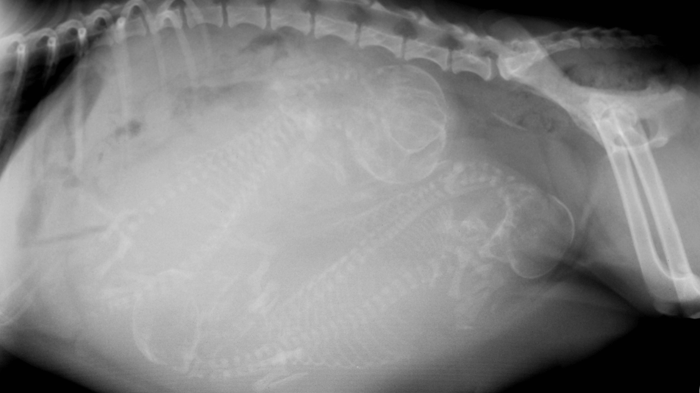
If you suspect your dog may be pregnant, the best way to confirm it is by visiting a veterinarian. A vet can perform a physical examination and determine whether or not your dog is pregnant. In addition, there are several tests that a vet can perform to confirm pregnancy.
It’s vital to ask your vet for x-rays around the one month mark, as this way you know how many puppies to expect during the birth. Knowing how many puppies to expect prepares you for complications in case one gets stuck in the birth canal or isn’t expelled from the womb.
Ultrasound Examination
An ultrasound examination is a non-invasive way to confirm pregnancy in dogs. During the examination, a veterinarian will use an ultrasound machine to view the developing fetuses in the uterus. This type of examination can be performed as early as 25 days after breeding. It can also provide information about the number of fetuses and their development.
Hormone Tests
Hormone tests are another way to confirm pregnancy in dogs as early as day 21. A veterinarian can perform a blood test to measure progesterone or relaxin levels in a dog’s blood. Progesterone levels rise during pregnancy, so an increase in progesterone can indicate pregnancy.
Palpations
Small swellings can be examined along the uterine 21-30 days after breeding. These swellings double in size every week until days 35 to 38. This method isn’t as reliable as the others.
X-rays
X-rays are a more invasive way to confirm pregnancy in dogs. X-rays can confirm pregnancy and provide information about the number of fetuses, their size, and their development. However, X-rays should not be performed until later in pregnancy, as the developing fetuses may be too small to be seen on an X-ray.
Caring for a Pregnant Dog
Proper Nutrition
Feed the dog small, frequent meals throughout the day to help maintain her energy levels. This is because the puppies take up space in her stomach, reducing her capacity to eat even when she has an appetite. Provide plenty of fresh water to keep the mother hydrated.
Proper nutrition at this time is vital, so be sure to read our article on what to feed a pregnant and nursing dogs as incorrect nutrition and supplementation during this time is extremely common.
Regular Exercise
Preparation for Whelping
Provide the mother dog with comfortable bedding and plenty of space to move around. It is also essential to have a veterinarian on call in case of any complications during delivery.
Caring for a pregnant dog requires attention to detail and a commitment to providing the best care possible. With proper nutrition, regular exercise, and preparation for whelping, the mother and her puppies can stay healthy and happy.
Frequently Asked Questions (FAQs)
How soon can you tell if a dog is pregnant?
What are the early signs of dog pregnancy?
Are there any reliable home pregnancy tests for dogs?
What should I do when my dog is pregnant for the first time?
What are the symptoms of dog pregnancy in week 4 and week 5?
How do I monitor my dog’s pregnancy week by week?
Conclusion
Determining if a dog is pregnant can be challenging, but it is essential to ensure the health and safety of both the mother and her puppies. Signs of pregnancy in dogs include a bigger abdomen, increased appetite, less energy, mood changes, and vomiting sometimes. A vet will more accurately test for pregnancies with hormone tests, ultrasounds, and x-rays.


